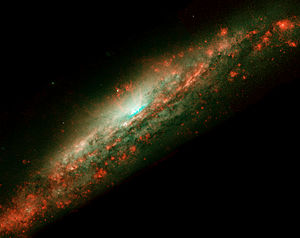NGC 3079
| Galaxie NGC 3079 | |
|---|---|
 | |
| Aufnahme des Hubble-Weltraumteleskops | |
| AladinLite | |
| Sternbild | Großer Bär |
| Position Äquinoktium: J2000.0, Epoche: J2000.0 | |
| Rektaszension | 10h 01m 57,8s[1] |
| Deklination | +55° 40′ 47″[1] |
| Erscheinungsbild | |
| Morphologischer Typ | SB(s)c / LINER / Sy2[1] |
| Helligkeit (visuell) | 10,8 mag[2] |
| Helligkeit (B-Band) | 11,5 mag[2] |
| Winkelausdehnung | 8,1′ × 1,3′[2] |
| Positionswinkel | 165°[2] |
| Flächenhelligkeit | 13,2 mag/arcmin²[2] |
| Physikalische Daten | |
| Zugehörigkeit | NGC 3079-Gruppe LGG 188[1][3] |
| Rotverschiebung | 0.003723 ± 0.000003[1] |
| Radialgeschwindigkeit | (1116 ± 1) km/s[1] |
| Hubbledistanz H0 = 73 km/(s • Mpc) | (53 ± 4) · 106 Lj (16,1 ± 1,1) Mpc [1] |
| Absolute Helligkeit | −20,1 mag |
| Durchmesser | 125.000 Lj |
| Geschichte | |
| Entdeckung | Wilhelm Herschel |
| Entdeckungsdatum | 1. April 1790 |
| Katalogbezeichnungen | |
| NGC 3079 • UGC 5387 • PGC 29050 • CGCG 266-008 • MCG +09-17-010 • IRAS 09585+5555 • 2MASX J10015792+5540480 • GC 1983 • H V 47 • Holm 156A • LDCE 700 NED002 | |
NGC 3079 ist eine Balken-Spiralgalaxie mit aktivem Galaxienkern vom Hubble-Typ E3 im Sternbild Großer Bär am Nordsternhimmel. Sie ist schätzungsweise 53 Millionen Lichtjahre von der Milchstraße entfernt und hat einen Durchmesser von etwa 125.000 Lichtjahren.
Im selben Himmelsareal befindet sich u. a. die Galaxie NGC 3073.
Aus dem Zentrum dieser Galaxie schießen heiße Gase heraus, die etwa 3.000 bis 3.500 Lichtjahre groß sind. Sie stammen von heftigen Sternbildungen, sogenannten Starbursts.[4]

Die Typ-Ic-Supernova SN 2001ci wurde hier beobachtet.[5]
Das Objekt wurde am 1. April 1790 von dem deutsch-britischen Astronomen Wilhelm Herschel entdeckt.[6]
NGC 3079-Gruppe (LGG 188)
| Galaxie | Alternativname | Entfernung/Mio. Lj |
|---|---|---|
| NGC 3079 | PGC 29050 | 53 |
| NGC 3073 | PGC 28974 | 53 |
| PGC 29229 | UGC 5421 | 53 |
| PGC 29472 | UGC 5459 | 52 |
| PGC 29469 | UGC 5460 | 51 |
| PGC 29584 | UGC 5479 | 52 |
Literatur
- König, Michael & Binnewies, Stefan (2019): Bildatlas der Galaxien: Die Astrophysik hinter den Astrofotografien, Stuttgart: Kosmos, S. 420
Weblinks
Einzelnachweise
Auf dieser Seite verwendete Medien
This NASA/ESA Hubble Space Telescope image shows the lumpy bubble of hot gas located at the center of the NGC 3079 galaxy's disk. Astronomers suspect that the bubble is being blown by "winds" (high-speed streams of particles) released during a burst of star formation. Gaseous filaments at the top of the bubble are whirling around in a vortex and are being expelled into space. Eventually, this gas will rain down upon the galaxy's disk where it may collide with gas clouds, compress them, and form a new generation of stars. The two white dots just above the bubble are probably stars in the galaxy.
The full image of NGC 3079 is 4.9 arcminutes (roughly 21 kpc or 70,000 light-years) along the diagonal. The bubble that resides at the center of NGC 3079 is more than 3,000 light-years wide and rises 3,500 light-years above the galaxy's disk.

